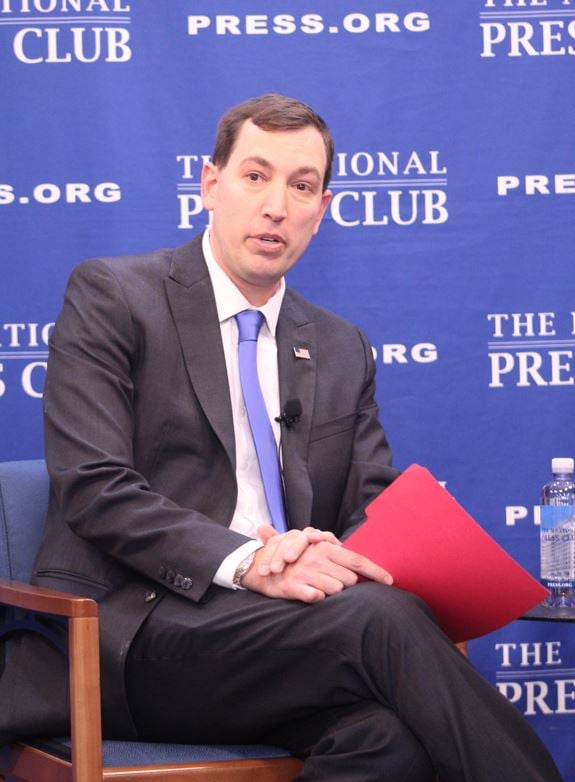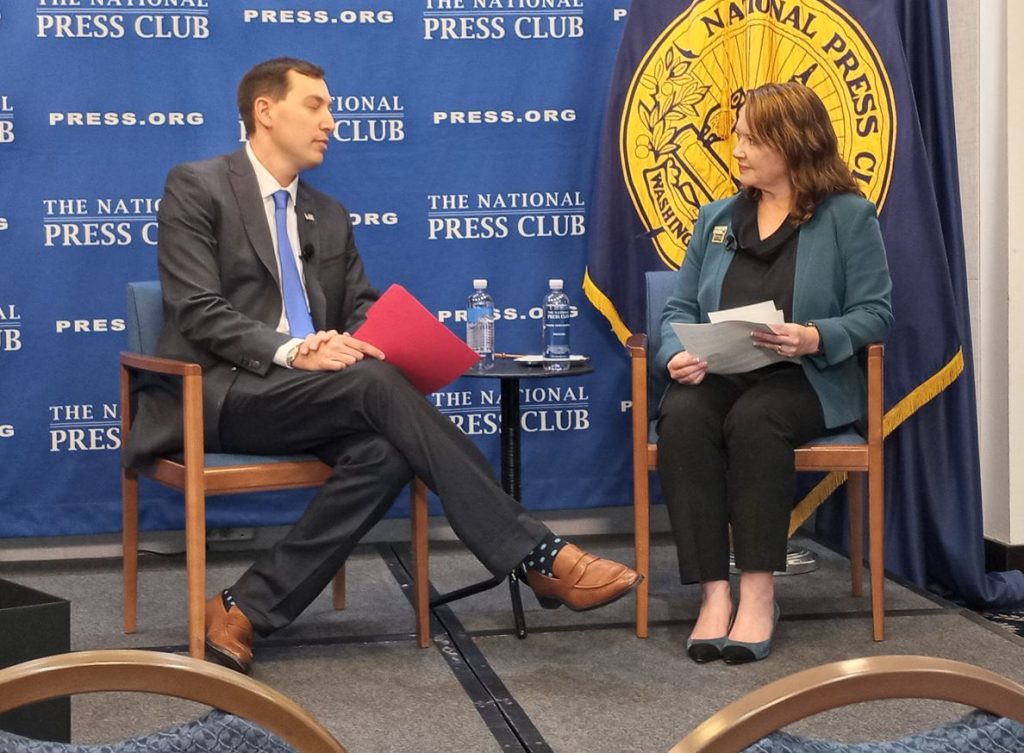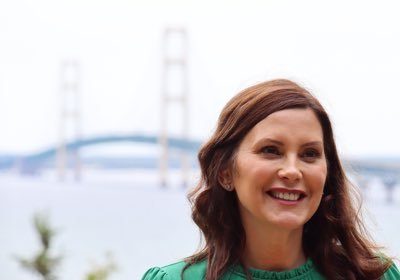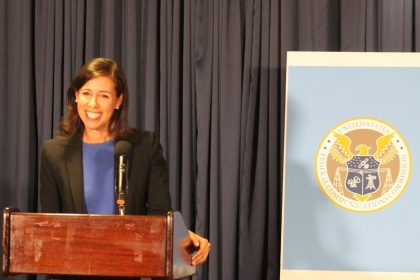AMA President Warns of Looming Physician Shortage

WASHINGTON — A looming physician shortage threatens to push the nation’s already struggling health care system past its breaking point, potentially placing millions of future patients at risk, the president of the American Medical Association said on Wednesday.
Worse, Dr. Jesse M. Ehrenfeld said during an early afternoon “newsmaker” event at the National Press Club, the early signs of the “insidious crisis” are already here, though hardly anybody is paying “the attention to it that it deserves.”
The crisis is widespread physician burnout, and Ehrenfeld said Wednesday he fears the situation will get decidedly worse if the Congress, the White House, states and the profession itself don’t take steps to curb it.
As has now been well documented, the COVID-19 pandemic slammed the physician workforce, especially in primary care, pushing an untold number of practitioners into a profound state of mental and physical exhaustion.
It has been projected by the Association of American Medical Colleges and others that the deficit in physicians could reach the hundreds of thousands over the next decade, a time when tens of millions of baby boomers will be on Medicare and the nation’s chronic disease burden is expected to climb dramatically.
Already, a number of hospitals across the nation are reporting critical staffing shortages.
One recent study found that South Carolina is currently leading the nation in critical staffing shortages, with 26.6% of its hospitals reporting they have health care positions that are going unfilled and have exhausted all options of filling them.
Maryland came in second, at 24%, followed by Michigan (17.3%), Delaware (10%) and Virginia, at 9.6%.
But as Ehrenfeld quickly made clear, numbers don’t tell the whole story. At the beginning of his remarks, he explained how the crisis has already touched him personally.
He began by telling the story of a “dear friend,” a medical school classmate, who, as an emergency room physician in California, was working on the frontlines of the COVID pandemic when he took his own life.
“He was an energetic and loving soul; a brilliant, caring doctor who felt the weight of the pandemic on his shoulders,” Ehrenfeld said. “He struggled to get out from under it. And I knew he struggled. But I didn’t know how to help him. And he didn’t know how to ask for help.”
The AMA president said he is still deeply troubled by his friend’s death, “just as I am haunted, knowing that there are thousands of people in his community who can no longer receive his care.”
More recently, Ehrenfeld said, he watched as another exceptional physician, a woman he’d personally recruited to lead the LGBTQ health clinic at the Vanderbilt University Medical Center, packed up her things after she abruptly quit the program.
“She said she was no longer able to cope with the political pressures and distorted half-truths about the work she was doing,” he said.
After packing her office and hugging friends and colleagues goodbye, Ehrenfeld said, she moved to another state to practice medicine unfettered by the restrictive laws she encountered in Tennessee.
“Sadly, she’s not the first, the last or the only physician I know who has made the difficult choice to leave a community or state they love because of legislative overreach in order to practice medicine the way they know it ought to be practiced.”
Though his first two anecdotes were sobering enough, Ehrenfeld added a third.
“It happened just the other day,” he said. “I had walked into the physician’s lounge at the Medical College of Wisconsin in Milwaukee, where I’m an anesthesiologist, and there I saw an experienced colleague, who I know well, completely break down. So clearly exhausted, and overwhelmed.
“So this is a picture of our health care system in 2023. It’s not a happy, or an uplifting one,” he said.
Ehrenfeld went on to explain that a number of factors are driving situations like these, as well as a growing exodus from medicine in general.

“One of the first things physicians will tell you is that an increasingly impersonal bureaucratic health care system is placing enormous administrative hassles and burdens in their laps every day, making them feel powerless to make meaningful change,” he said.
“Physicians today, on average, spend two hours on paperwork for every one hour we spend with patients,” he added.
Another factor is the ongoing attack on science by some on the far right that has undermined trust in “our medical institutions, and too often leads to threats and hostility directed at us and other health care workers,” Ehrenfeld said.
Still another factor is government intrusion into health care decisions “and aggressive efforts in many states to criminalize care that is supported by science and evidence,” he said.
And then there’s the growing trend in consolidation across the health care sector that is giving greater power to the nation’s largest hospitals and insurers, and less autonomy and fewer choices to patients and doctors.
“At the same time, a shrinking Medicare reimbursement rate for physicians has pushed many small, independent practices to the brink of financial collapse and jeopardized care for millions of America’s seniors,” Ehrenfeld said.
The net result of all this, the AMA president said, is that physicians “in every state and every specialty” are increasingly, and “in increasingly worrying numbers,” turning their backs on a profession to which, in many cases, they’ve dedicated their whole lives.
The results of this, it’s almost needless to say, are staggering.
Ehrenfeld said it is estimated that more than 83 million people in the U.S. currently live in areas without sufficient access to a primary care physician.
“In large parts of Idaho, and Mississippi, pregnant women can’t find OB-GYN to care for them, and 90% of counties in the U.S. are without a pediatric eye doctor, while 80% are without an infectious disease specialist,” he said.
Ehrenfeld said more than a third of Black Americans live in so-called cardiology deserts, and he noted that even his own parents lost their primary care physician because the Medicare payment rates for doctors have plummeted and he decided he could no longer afford to see Medicare patients.
“In short, the physician shortage that we have long feared and warned was on the horizon is here,” he said. “It’s an urgent crisis in every corner of this country, urban and rural, with the most direct impact hitting families with high needs and limited means.
“Imagine walking into an emergency room in your moment of crisis in desperate need of a physician’s care and finding no one there to take care of you. That’s what we’re up against,” he said.
And according to Ehrenfeld, it’s all about to get much, much worse.
“Consider that roughly two-in-three doctors admitted to experiencing burnout during the pandemic in a recent survey conducted by the AMA in collaboration with the Mayo Clinic and Stanford Medicine,” he said. “That is the highest level of burnout we’ve ever recorded.
“And consider that one-in-five physicians surveyed during the pandemic said that they plan to leave medicine within the next two years, while one-in-three said they were going to cut back on their hours,” he said. “And consider that nearly half of all practicing physicians in the U.S. today are over age 55, while foreign-trained physicians are facing enormous obstacles when it comes to immigration and green card delays.”
While Ehrenfeld acknowledged that medical school applications are actually on an upswing, he reminded his listeners that it can take a decade or more to educate and train a physician, and that the average young doctor today leaves medical school more than $250,000 in debt.
“That huge debt load has implications for our health care system, often forcing aspiring physicians to bypass primary care and less populated rural areas in favor of more lucrative specialties in or near large cities,” he said.
But as stark as Ehrenfeld’s assessments were, he also said the situation is not hopeless.
His prescription for beginning to solve the crisis is highlighted in the AMA’s Recovery Plan for America’s Physicians, a document it released last year.
The plan itself is based on five key pillars:
- Supporting telehealth to maintain coverage and payment.
- Reforming Medicare payments to promote thriving physician practices and innovation.
- Stopping scope creep that threatens patient safety.
- Fixing prior authorization to reduce the burden on practices and minimize care delays for patients.
- Reducing physician burnout and addressing the stigma around mental health.
The AMA president said the overall goal of the plan is to put our health care system on a sustainable path and ensure all patients have access to the care they need when they need it.
Best of all, they’ve already been rolled into three bills with strong bipartisan support that are already pending before Congress.
These bills would, among other things, expand residency training options, provide greater student loan support, and create a smoother pathway for foreign-trained physicians to enter the nation’s workforce.
“Implementing these solutions would make a huge difference in our ability to hold on to the physicians we have and strengthen our physician workforce, positioning our nation to better respond to an aging population and the next public health crisis we will eventually face,” Ehrenfeld said.
During a moderated question-and-answer session with National Press Club President Eileen O’Reilly, Ehrenfeld also mentioned another needed reform, “reducing the administrative burden associated with the overused and inefficient ‘prior authorization process.’”
“This is a process insurers use to try to control costs, but it forces physicians and their staff to spend an average of two business days a week completing prior authorization paperwork, including submissions and appeals when insurers inappropriately deny care or treatments often already in wide use,” he said.
“This onerous process not only frustrates doctors and drives up health care costs, it’s just downright demoralizing,” Ehrenfeld continued. “In one recent AMA survey, 80% of physicians told us they’ve had patients abandon treatment, due to prior authorization struggles with insurers, and two-thirds said that authorization delays have led to additional office visits.
“This issue also lies in the hands of Congress in the form of the pending, bipartisan Improving Seniors’ Timely Access to Care Act, which would expand prior authorization reforms that were finalized by the Centers for Medicare and Medicaid Services.
“It’s also in the hands of the Biden administration, which can significantly improve the prior authorization landscape if it finalizes regulations that have already been proposed, and in the hands of state legislatures, many of which are considering their own reform measures,” he said. “About a dozen states have already passed comprehensive prior authorization reforms this year, but much more needs to happen.”
The scheduling of Ehrenfeld’s appearance at the National Press Club coincides with the publication of a new report detailing how the COVID-19 pandemic impacted physicians.
The report, “Addressing the Healthcare Staffing Shortage,” was released by Definitive Healthcare, a health care commercial intelligence company based in Framingham, Massachusetts.
Among its other findings is that roughly 8,700 internal medicine physicians and 7,800 family practice physicians left the workforce in 2021 and 2022.
And these were just a percentage of the more than 71,300 doctors who are believed to have left health care due to various effects of COVID-19.
More bracingly, that tally does not include nurses, physical therapists, physician assistants or licensed clinical social workers.
When they are included, Definitive Healthcare suggests more than 145,000 clinicians and health care providers threw in the towel as a result of the extraordinary pressure they faced during the pandemic.
The report also noted the effects of shelter-in-place orders and fear of catching COVID-19 by visiting physicians’ offices, hospitals and health facilities.
“It’s no secret that the pandemic transformed the way patients engage with their doctors and receive care,” the report said. “Unable to visit their doctors face-to-face, patients instead turned to outpatient clinics, ambulatory surgery centers, and home health care agencies, and used telemedicine to get the care they needed.”
Like Ehrenfeld, Definitive Healthcare also points to potential strategies for addressing the issue.
These include:
- Expanding access to telemedicine to reduce facility operating costs.
- Confronting burnout, particularly with best practices to prevent suicide, and stigma and shaming for clinicians who seek mental health assistance.
- Expanding the nation’s Graduate Medical Education, especially to help rural areas.
“The bottom line is we must ensure that you, me and everyone else in America has a physician to care for them, or a parent or a family member, in their time of need,” Ehrenfeld said. “Most of these solutions have bills pending in Congress with strong bipartisan support and momentum growing in many states to put other safeguards in place.
“You know, there isn’t much that our two major political parties see eye to eye on right now. But on these issues they do,” he continued. “We just need the will — and the urgency — to get it done.
“We need leaders in Congress to step forward and make this happen. Sadly, every day we wait, the size of this public health crisis grows. We need action today,” Ehrenfeld said.
Dan can be reached at [email protected] and @DanMcCue

























